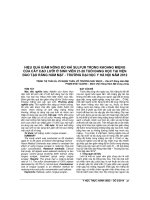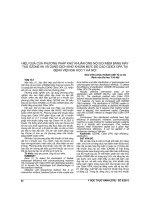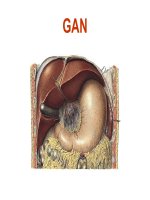Đại học y hà nội scientific writing
Bạn đang xem bản rút gọn của tài liệu. Xem và tải ngay bản đầy đủ của tài liệu tại đây (472.38 KB, 34 trang )
Scientific Writing
Manuscript structure and Journal Standards
Dr Leigh Jones, OUCRU, Head of Training
Hanoi Medical University, June
POLL
Scientific writing: What is your experience level?
CHATBOX
What do you find difficult about scientific writing?
www.ipmph.edu.vn
www.ipmph.edu.vn
Learning Objectives
1. Understand the structure of a paper
2. Appreciate the importance of journal standards
(ISI/Scopus)
www.ipmph.edu.vn
Scientific Writing
Manuscript Structure
www.ipmph.edu.vn
Initial message delivery!
• Peers
• Science Community
• Media and Government
• Public
www.ipmph.edu.vn
What makes a good/bad paper?
GOOD
•Clear message
•Concise/simple language
•Targets readership
•Puts into context
•Highlights importance
BAD
•Confused message/story
•Complex language •Irrelevant
info for reader
•Doesn’t “set the scene”
•Over-interpretation
www.ipmph.edu.vn
Manuscript Structure
•
•
•
•
•
•
Title and author list
Abstract
Introduction
Materials and Methods
Results (figures and legends)
Discussion
The structure is there to help YOU and to help your READER
www.ipmph.edu.vn
Manuscript Structure: Title
• KEY to making article “findable” (also keywords)
• Clear and self explanatory snapshot
• Descriptive and use specific rather than generic terms (e.g. use
‘ampicillen’ rather than
‘antibiotic’)
• No abbreviations/acronyms
• The title should report what the researcher has done by stating:
1. Subject/patient
2. Manipulation/what are you doing?
3. Output parameter/result
• Which readers are you targeting?
• Make the title interesting and appealing to your target audience
• Descriptive vs declarative? Check journal guidelines
www.ipmph.edu.vn
Manuscript Structure: Title (an example)
1. Does Vaccinating Children and Adolescents with Inactivated
Influenza Virus Inhibit the Spread of Influenza in Unimmunized
Residents of Rural Communities?
2. Influenza Vaccination of Children: A Randomized Trial
3. Effect of Child Influenza Vaccination on Infection Rates in Rural
Communities: A Randomized Tria
CHATBOX:
Which title do you like the best? Why?
/>
www.ipmph.edu.vn
Manuscript Structure: Title (an example)
1. Does Vaccinating Children and Adolescents with Inactivated
Influenza Virus Inhibit the Spread of Influenza in Unimmunized
Residents of Rural Communities?
2. Influenza Vaccination of Children: A Randomized Trial
3. Effect of Child Influenza Vaccination on Infection Rates in Rural
Communities: A Randomized Trial
Short
Easy to understand
Conveys key points of the study (population, trial design, output)
/>
www.ipmph.edu.vn
A brief note about Epidemiological Titles
Tend to be more descriptive than declarative
1. Subject/species
2. Output parameter/result
3. Location
4. Study design (optional; cohort, case-control, crosssectional, ecological)
www.ipmph.edu.vn
Should you have fun with your title?
• Wordplay and witty titles on the rise but still uncommon
Journal dependent
• May increase downloads BUT fewer citations
• Wordplay can be highly cultural so may not always be
understood
• May be best suited to review articles
• Must still reflect the work!
/>
www.ipmph.edu.vn
Manuscript Structure: Authorship list
• Multi-author collaborative efforts
• ICMJE has authorship guidelines used by many key institutions
• The basic guidelines state that to be considered as an author the
researcher must meet three basic criteria:
1. Involvement in designing, collecting data or analysing
2. Participation in drafting
3. Approval of final manuscript/report
• Authorships should NOT be misused e.g. ‘guest authorships’
• Order:
• The first author is the person who carried out the bulk of the
research
• The last author is the principal investigator who runs the lab
www.ipmph.edu.vn
Manuscript Structure: Abstract
• More people read this than the full paper
• Distilled version of paper (200-250 words)
• Self explanatory
• Short/concise BUT often most difficult to write
• What SHOULD/SHOULD NOT be in the abstract?
Purpose/question
X Literature review
GENERAL M&M
X Content not in paper
SUMMARISED results
X DETAILED M&M
MAJOR conclusions
X References
www.ipmph.edu.vn
Manuscript Structure: Introduction
• From general to specifics
• Start by putting your work in a broader
context then focus on your specific research
question
• The introduction should have four main parts
1. Context – a brief background of the subject
area
2. Need/gap – requirement for your study?
3. Task – what did you do to address the need?
4. Object/outcome –major conclusions
OR Objectives/hypotheses – keep the mystery!
• The introduction should mentally prepare the
reader for the structure of the document to
follow
www.ipmph.edu.vn
Manuscript Structure: Materials and Methods
• What would a person wishing to repeat the study ask you?
• It should explain how the experiment(s) was carried out with details on
• Experimental design
• Apparatus
• Data/specimen gathering methods
• Control groups
• Statistical tests used
• NOT the same as a protocol or laboratory book notes.
• DON’T say “First pour agar into six petri dishes. Then inoculate with
bacteria. Then put into the incubator”
• DO say “Agar was inoculated with bacteria and incubated for ten hours”
• Don’t list standard equipment e.g. say “standard microscopic techniques”
• Lots of listed information such as primer sequences? Use a table/list
www.ipmph.edu.vn
Manuscript Structure: Results
• All figures/graphs should be referred to and described in the results
• Keep interpretation to discussion
1. “The results are shown in Table 1”
2. “The decreased expression of proinflammatory genes, as shown in
Table 1, is evidence that the test drug A is a viable option as an
alternative therapy in autoimmune disease. In a review by Smith
and colleagues, the currently available therapies are less effective
at……”
3. “As shown in Table 1, administration of the drug resulted in a
decreased expression of proinflammatory cytokines…..”
www.ipmph.edu.vn
Manuscript Structure: Results
• All figures/graphs should be referred to and described in the
results
• Keep interpretation to discussion
“The results are shown in Table 1”
“The decreased expression of proinflammatory genes, as
shown in Table 1, is evidence that the test drug A is a viable
option as an alternative therapy in autoimmune disease. In a
review by Smith and colleagues, the currently available
therapies are less effective at……”
“As shown in Table 1, administration of the drug resulted in a
decreased expression of proinflammatory cytokines…..”
www.ipmph.edu.vn
Manuscript Structure: Figures and
Figure Legends
• All figures must be easily read and decipherable with
accompanying figure legends
• Tables and figures must be understood WITHOUT reading the
results section
• A good figure legend should include:
• Brief title of figure as first sentence.
• Organism studied (where applicable)
• Treatment applied/relationship displayed
• Experimental readout
• Brief method
• Location (in a field experiment)
• Sample sizes • Statistical test summaries
www.ipmph.edu.vn
Manuscript Structure: Figures and
Figure Legends
Figure a: Interleukin-21 regulates
immunoglobulin A (IgA) production. Fecal
pellets were collected from age-matched wildtype, IL-21-/- and IL-21R-/- B6 mice. IgA
levels were quantified through enzyme linked
immunosorbent assay (ELISA) and
normalized to total protein. N=4 mice per
group; data are reflective of two independent
experiments. *P <0.05 compared with wild
type mice
www.ipmph.edu.vn
Manuscript Structure: Discussion
•From specifics to general
•Interpret data rather than repeat
results
•This should include:
•Patterns between data; linking
data together
•Hypotheses vs actual results
•Differences/similarities to literature
•Negative as well as positive
results
www.ipmph.edu.vn
Manuscript Structure
• Title and author list
• Abstract
• Introduction
• Materials and Methods
• Results (figures and legends)
• Discussion
The structure is there to help YOU and to help your READER
www.ipmph.edu.vn
Scientific Writing
Journal Standards:
Institute for Scientific Information and Scopus
www.ipmph.edu.vn
• How do I know a journal is good quality?
• What standards are in place?
• Where can I find lists of good quality
journals?
www.ipmph.edu.vn









